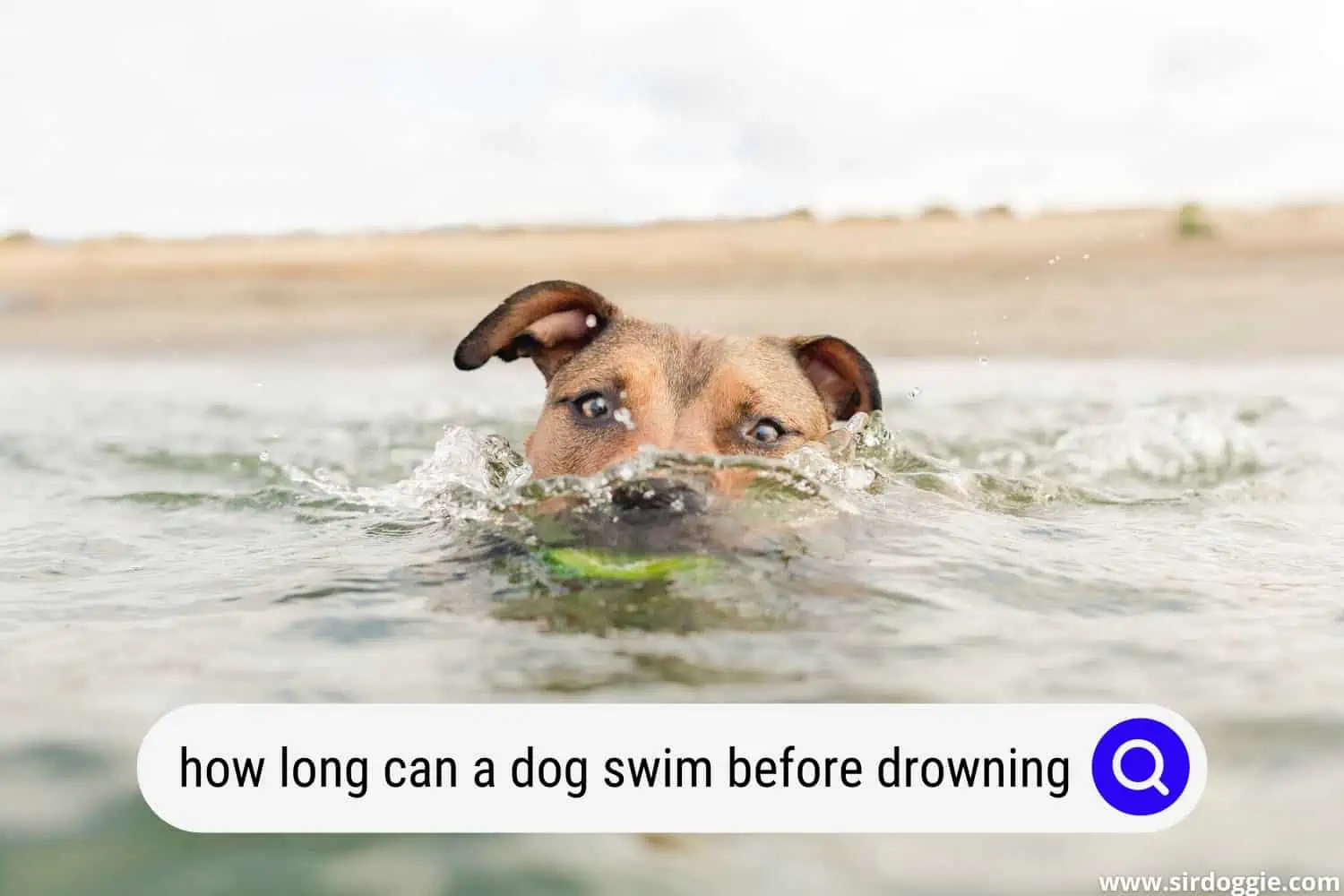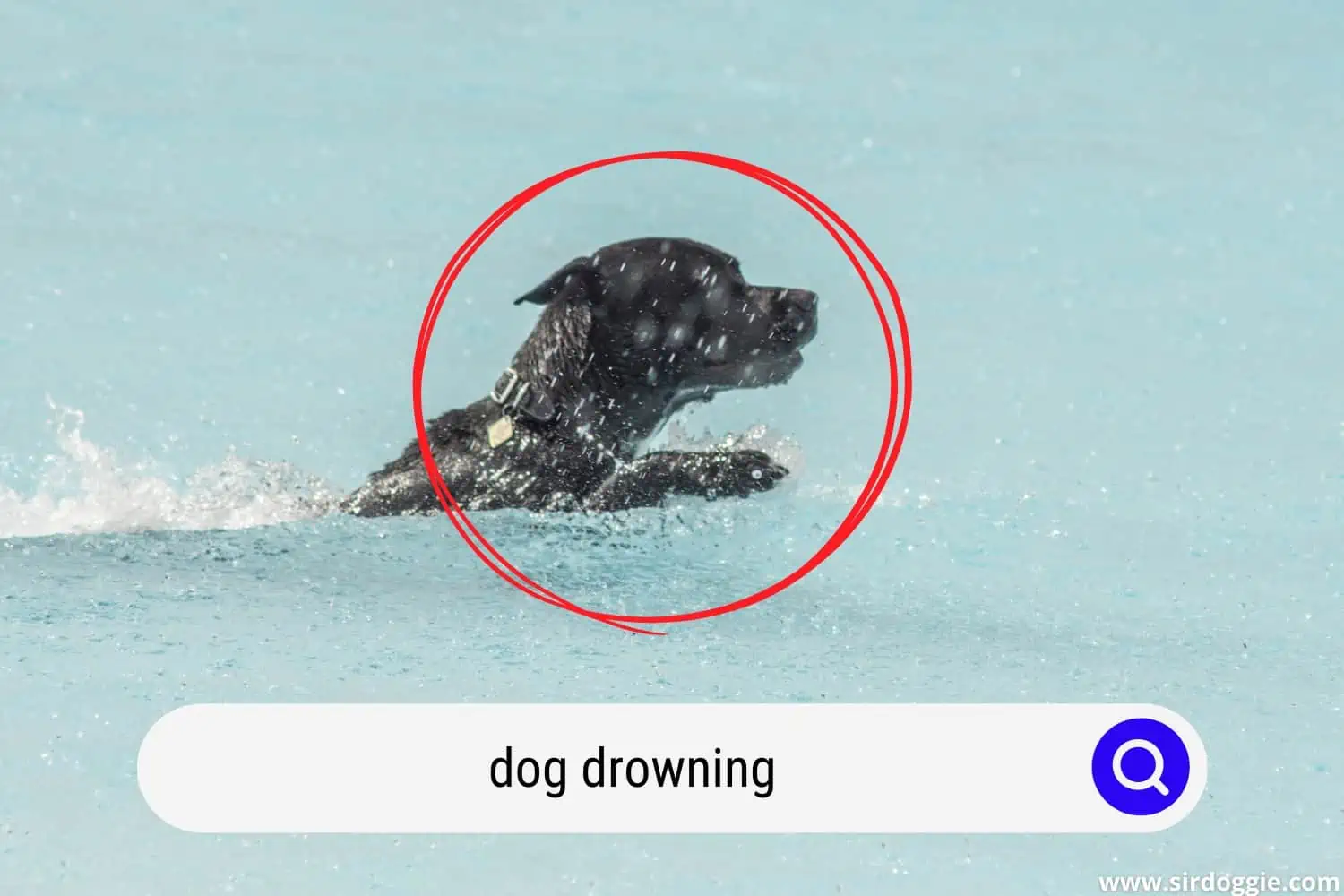How Long Can a Dog Swim Before Drowning?
Dogs, despite their reputation as excellent swimmers, are also still capable of drowning. They may panic when swimming if they become stuck in a strong current. They may also become fatigued if they are confined to water and unable to get out to rest. Both of these risks are especially true for canines in swimming pools, that have gone down into ice holes or have somehow managed to fall out into choppy seas. Dogs are easily capable of drowning in hazardous water conditions, but how much time does it take for this to occur? How long can a dog swim before drowning?

On average, a dog can only swim for about 10 to 30 minutes before succumbing to fatigue and drowning. However, the exact time varies depending on your dog’s training, energy level, health, age, and breed.
Swim training and a dog’s natural energy level heavily contribute to determining the exact time that a dog can swim or stay in the water without any encountering any life-threatening issues. Similarly, their overall health status and breed also matter. If your dog is healthy and belongs to a family of water dogs, such as being a poodle or one of the retrievers, they can generally withstand more time in the water before drowning.
Furthermore, swimming may be more difficult for older dogs than it is for younger dogs because they are older and may likely suffer from arthritis or other conditions that will make swimming more difficult for them. Dogs who have difficulty moving around on the ground will likely have just as much difficulty navigating water if they find themselves in rough conditions.
Young, healthy adult dogs with a natural propensity for swimming—as well as dogs with incredibly high amounts of energy—may be sometimes able to swim for hours at a time without becoming exhausted and without the risk of drowning.
Again, though, numerous factors are at play when it comes to determining how long a dog can survive in risky swimming situations before no longer being able to continue.
How Does a Dog Drown? How Does It Work?
Dog drowning occurs when water enters a dog’s mouth and is inhaled into the airways by the canine, making it impossible for them to breathe.
Having water in the lungs prevents the lungs from receiving the oxygen the dog needs to sustain life. The dog will then suffocate and drown due to a lack of oxygen stemming from the water that has filled their lungs.
It is quite tough for canines to prevent themselves from drowning on their own once water has been inhaled. Unless someone gets involved and saves them in such a situation, they will most likely drown in the sea or any other body of water that has managed to overwhelm them.
Signs & Symptoms That Indicate Dog Drowning
When your dog is at risk of drowning, you should look for these indicators that they may be struggling with water in the lungs and improper oxygen intake:
- Hypoxia (lack of oxygen)
- Cyanosis (blue discoloration of the skin due to lack of oxygen)
- Unconsciousness
- Labored breathing
- Irregular breathing with an open mouth
- Changes in posture
- Weak pulse
- Hypothermia (drop in body temperature)
Make note of any of the symptoms your dog may be experiencing, and call your veterinarian immediately.
What to Do If Your Pup is Drowning
If your dog drowns, you will need to do the following things to ensure your pup’s safety:
- The water in the lungs must be removed immediately. If water remains inside of the lungs, your dog will be unable to breathe and get the oxygen that’s required for their brain and body to continue functioning, and they will die.
- To remove water from the lungs, for smaller dogs, you may be able to hold them up by their back legs, allowing the water to flow out from their lungs and restore proper breathing capabilities. You may also like the dog down at an angle to encourage the water to flow outward from its mouth. For larger dogs, you will need to lie them on their backs or sides and do chest compressions to try to expel the fluid from the lungs.
- The dog’s airways must be cleared, and artificial respiration must be administered as quickly as possible if he or she is not breathing. You will need to blow air into the canine’s lungs once every three to five seconds.
Your pooch should be kept warm (if struggling with a lowered body temperature) and comfortable until he or she has regained consciousness and can breathe normally again. Keep in mind that a dog that has recovered from drowning may experience shock, so keep the surrounding environment peaceful until the dog is ready to get up and roam around.
Regardless of whether you can fully help your dog recover or not, you must call your veterinarian for a quick phone consultation regarding the next steps of care, such as symptoms to monitor your dog for after drowning or the potential need for coming in for a checkup despite improvement.
Helping Your Dog After Drowning
While waiting for your dog to recover, you should dry any wet fur with a towel, but avoid rubbing your dog’s body too hard. Instead, blot the wet fur dry. This will help regulate your dog’s body temperature and avoid causing him or her to get any chills or other issues while so much other trouble is currently going on.
If your pup is conscious, give him or her some love and attention, and try to keep them comfortable until you can make it to the veterinarian’s clinic. If your dog is unconscious, keep your pet’s head level with the rest of their body (if water has already been removed from the lungs) and monitor their breathing and heart rate to the best of your abilities.
Crucial Tips for the Safety of Your Dog While Swimming
When swimming with your dog, the best way to prevent drowning is to take steps to ensure safe swimming practices.
- First and foremost, make sure the water is clean and free of debris before allowing your pet to enter any body of water. It’s important to keep your furry companion away from algae as well since it can contribute to certain health conditions in dogs.
- Try to train your dog to swim in the water. Some dogs appear to almost naturally swim, but many need a bit of help learning what to do. (For certain breeds, such as English Bulldogs, swimming is something they should not be participating in due to health risks.) In general, though, a dog should be taught both how to swim as well as taught to understand how to behave in and around water.
- Maintain a cheerful and stress-free atmosphere for your pup while swimming. Swimming should be a fun and pleasant activity for you and your dog. Making it stressful can contribute to your dog panicking or making mistakes in the water which can jeopardize their health.
- If you see that your canine buddy is becoming fatigued, stop the swimming session immediately since fatigue is guaranteed to increase the likelihood of your dog drowning. Never push your dog too hard in the water, and always provide adequate breaks and fresh drinking water for them to rehydrate.
- It is important to remember that moisture in your dog’s ears may create the perfect environment for an ear infection, so carefully wipe your pooch’s ears after swimming in the pool, too.
- Furthermore, invest in a high-quality life jacket for your dog, especially if you plan to play or swim in larger and/or deeper bodies of water that come with much more risk to both of you.

FAQs
Is it possible for a dead dog to float in water?
After a certain amount of time after death has passed, yes. When the air in a pet’s lungs is substituted with water, the body begins to sink. Once immersed, the body remains underwater until the microorganisms (bacteria) in the gastrointestinal tract and chest cavity make enough gas during the decaying process to cause the body to float to the surface.
Is it harmful for canines to swim in cold water?
Allowing your dog to swim in chilly or cold water is not recommended. Dogs, much like people, can get hypothermic when exposed to cold water, but they will not recognize that the water is the source of their discomfort. The basic guideline is that if you have to get out of the ocean or other body of water because you are feeling chilly, your dog is in danger of getting cold as well. However, for breeds like Newfoundlands or Saint Bernards, cold water is rarely a concern.
Is too much swimming harmful to a dog’s health?
Swimming sessions that are short to moderate in duration are normally safe. However, excessive exposure to chemicals (in a swimming pool or ocean) can irritate the dog’s eyes, skin, and coat. Additionally, you do not want to overwork your dog, whether through swimming or other exercise, or else you risk causing them health problems.
What kind of dog is incapable of swimming?
Several prominent dog breeds are unable to swim owing to their anatomy and body structure. These dog breeds include the following:
- English Bulldogs
- Basset Hounds
- Dachshunds
There are additional breeds that may struggle to swim but can do so with the proper gear and supervision. But remember, even dogs with ideal anatomy and body structure may also find it difficult to swim in certain conditions if they have dense, thick fur coats. A dog’s ability to swim relies on many factors, so these will need to be taken into account if deciding that swimming is an activity you’d like your dog to participate in with you.
Related Reading: How Far Can A Dog Swim

Family Dog Expert Author
Hi there! I’m Stuart, a devoted dog lover and family dog expert with over a decade of experience working with our furry companions. My passion for dogs drives me to share my knowledge and expertise, helping families build strong, loving bonds with their four-legged friends. When I’m not writing for SirDoggie, you’ll find me hiking, playing with my beautiful dog, or studying music.